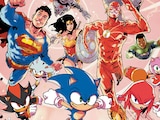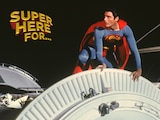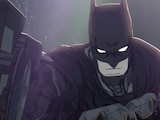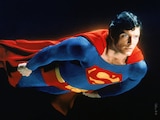Season 2 of Batwoman is officially live, and everyone’s talking about Ryan Wilder. When it comes to TV, DC has always been known for its boldness (and bravery), but changing your main character one season in is a status quo shift of a completely different level. Still, with DC’s long history on the small screen, it isn’t the first time we’ve broken new ground after a show was already in full swing. In fact, you could say it’s something of a tradition with us.
Wait…is that skepticism I sense? Well, allow me to show you. Here’s a look back at some of the wildest changes in direction of a DCTV show in progress.
1955: The Adventures of Superman…in Color!

DC’s first foray into television is one still held dear by lifelong fans, who tuned in on the family TV set every week to see George Reeves fly through the air and give the bad guys what-for on The Adventures of Superman. But by the third season, the show took on a completely different tone when color TVs started making their way into living rooms across America. For the first time, people bore witness to a real live Superman dressed in brilliant reds and blues, and superhero television would never be the same again. Some diehards still prefer the subdued tone of the first two “black and white seasons” over the “color seasons,” but the oversized whimsy of those later years were as true to the Silver Age source material of the time as you could get.
1968: Na Na, Na Na, Na Na, Na Na, Batgirl?

“Batmania” was an international phenomenon in 1966 when Adam West and Burt Ward took to the airwaves as Batman and Robin. But by its third season, Batman was in need of a new dash of flavor. Enter Yvonne Craig as Batgirl, daughter of Commissioner Gordon and fledgling crimefighter created especially for the show. Not only did the introduction of a vigilante whose identity was even unknown to Batman and Robin change the show’s entire dynamic, but the creation of Batgirl (introduced to comics a year earlier while the season was in development) changed the mythology of Batman itself for all time.
1977: WW77

Patty Jenkins’ Wonder Woman movies weren’t the first to cast the Amazon Princess back in the past—season one of the Lynda Carter Wonder Woman TV show was originally set at the height of World War II, with Diana fighting alongside American air forces to beat back the Nazis and their allies. But even though the show was a hit, maintaining the period piece nature of the show became prohibitively expensive for the series by the second season, causing the network to rethink their approach, and by season two, the Immortal Wonder Woman found herself in modern day 1977, fighting war crime as a government agent alongside Steve Trevor Jr, the grown son of her wartime lover. Similar enough on paper, perhaps, but the very ‘70s trappings of the then “modern” setting have aged these later seasons in a different way than that timeless first year.
1978: Super Friends, Super-Villains

Perhaps no show in TV history was more familiar with format changes than Super Friends, the animated series which brought DC’s greatest heroes together on Saturday mornings from 1973 to 1985. At the time, it was novel in and of itself to see the likes of Wonder Woman and Aquaman working together on screen, but restrictive guidelines which kept the Super Friends from directly battling enemies kept the program rather sedate for its first two seasons. It wasn’t until 1978’s Challenge of the Super Friends that viewers were taken for the first time into the bowels of the Hall of Doom, where the Super Friends’ greatest adversaries from the comics joined forces to bedevil their heroic foes like never before. Starting with this long-delayed season three, the universe-spanning battle between the combined forces of good and evil could finally be played out beyond the comic book pages, and Super Friends would never be the same.
1996: I Now Pronounce You Superman and Wife

To give you a sense of just how gripping the dramatic tension between Lois and Clark was in the ‘90s on Lois and Clark: The New Adventures of Superman, the only reason the entire Death of Superman arc even happened in the comics was to give the show enough time to resolve its steamy will they/won’t they tension so that the long delayed nuptials of their pencil-and-ink counterparts could stay in sync. After three seasons of teasing, the Daily Planet’s ace reporters finally tied the knot…and the show was now forced to find whatever it could to keep the drama going. With their romance consummated, Lois & Clark spent its final season embroiled in more wild and fantastic scenarios than ever before, using and expending all the tricks you could find in a writer’s room to keep the show alive. It’s always a challenge to keep a romantic series going when the romance in question is mutually resolved, and one which, despite numerous delays, seems in hindsight to have taken the series by surprise.
2012: Young Adult Justice

No series in DC history has a stronger sense of time and place than Greg Weisman and Brandon Vietti’s Young Justice, which is meticulously time stamped and geographically pinned with every establishing shot. It may be a cartoon, but time for its hand-drawn characters progresses in a way not even as borne out by heroes of live action series, let alone their ageless comic book sources. So, when the beginning of Young Justice Season 2 suddenly jumped the entire world five whole years later, the entire viewership went into future shock. Characters we had come to intimately know as children were now young adults and fully fledged leaders with more mature problems than ever before and we were now getting to know an entirely new group of young heroes. This theme would repeat itself with another two-year time skip before Season 3, establishing these time jumps as part of the show’s essential fabric. It was only with the surprising start of this second season that we finally got a sense of what this show was truly about: not a specific group of young heroes, but how the youth takes on new challenges with every passing generation.
2017: All Hail Beebo!

Of the entire CW lineup of DCTV shows, DC’s Legends of Tomorrow is definitely the hardest to explain. It’s ostensibly a time travel show with an ensemble cast of C through Z list heroes (and sometimes villains) discarded by destiny to form an unlikely group to save the past, present and future from massive temporal chaos. The first season of Legends is full of bleak import as the team conspires to challenge their sworn enemy Vandal Savage across three different points in the time stream, but the whole time it was…missing something. The show only felt comfortable when it was letting its actors cut loose and revel in the unlikelihood of the premise, like when they started saloon fights and began hijacking timeships to The Captain and Tenille’s “Love Will Keep Us Together.”
As time went on, the Legends of Tomorrow cast and crew leaned deeper and harder into the silliness, soon becoming the most audacious and unpredictable superhero show on television. Where exactly the tipping point occurred is a matter of debate, but the point of no return was undoubtedly the third midseason finale, “Beebo the God of War”—where the hottest Christmas toy of 1992 is transported to 1000 AD, and becomes the object of worship for a Viking clan. The power of Beebo has sustained the Legends ever since, and their adventures have only gotten joyously further off the rails with time. Personally, I’m partial to the episode where John Constantine spends a whole day trying to cause a time paradox by kicking his own dad in the nards.
As you can see, DC has been making TV history for 65 years now—and Javicia Leslie donning the Batcowl as newcomer Ryan Wilder is only the latest chapter in a long legacy. What’s the next big turn that lies ahead for DCTV? We can’t tell you, but with over a dozen current and upcoming shows, along with plenty in development, chances are it’s only a remote click away.
Catch new episodes of Batwoman Sundays at 8 p.m. (7 p.m. CST) on The CW. Check out our official Batwoman show page for more articles, videos and news on Ryan Wilder and the rest of the Bat-Family.
Alex Jaffe is the author of our monthly "Ask the Question" column and writes about TV, movies, comics and superhero history for DCComics.com. Follow him on Twitter at @AlexJaffe and find him in the DC Community as HubCItyQuestion.




















